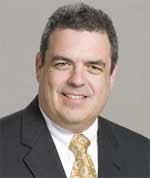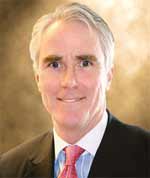MARKET REPORT
CARBON TRADING
Barack Obama’s support for carbon trading will help strengthen an already growing market.
 |
|
Schleimer: The Clean Air Act could be used to regulate greenhouse gases |
Bolstered by Europe’s legislative advances to tackle climate change and US president Barack Obama’s firm backing for a government-run system to cap-and-trade polluting carbon emissions, the emerging carbon trading market is holding its own despite a global economic downturn that has sent demand for and prices of oil into a tailspin.
While no one expects the government officials eking out a successor pact to the United Nations global climate treaty—whose mandatory limits on carbon emissions expire in 2012—to reach a definitive settlement anytime soon, most observers are sure a new agreement will be hammered out and the market for tradable carbon will continue to grow.
“It’s not like governments to reach an agreement before they have to, but the uncertainty won’t affect the market,” says Garth Edward, director of environmental products for Citi in London. “The Kyoto Protocol is relevant to the market but not driving all the elements. Regardless of the United Nations, the EU has set legislation that brings clarity to the market until 2020,” he adds, referring to the European parliament’s recent endorsement of a decision by 27 European Union nations in December to reduce EU carbon emissions by 20% of their 1990 levels by 2020 and extend the European Union Emission Trading Scheme until 2020.
 |
|
Cahill: Obama has shown commitment to addressing climate change. |
Martin Lawless, head of environmental financial products at Deutsche Bank in London, agrees that the carbon markets are here to stay. He believes the EU legislation, which calls for emission caps to become progressively tighter until 2020, will influence corporate decision-making by slapping a price on carbon and boosting a carbon-emitting company’s annual costs significantly. “It would be astonishing if there would not be a radical change in the behavior of companies…that there would not be a radical change in their investment decisions,” says Lawless.
His colleague Mark Lewis, head of global carbon research at Deutsche Bank in London, adds: “It’s patently wrong to say that carbon trading is not having an impact. As carbon prices go up and the cap becomes tighter over time, companies will take the long-term price of carbon into their thinking.” He believes there are already fewer large coal-fired plants being built in Europe as companies increasingly turn to gas and nuclear power for their energy needs.
London-based New Carbon Finance tracks the major emerging carbon markets around the world, including Europe, Australia and the United States, where it covers the planned regional markets and potential federal initiatives. And it is the potential United States market—where newly elected President Obama has set ambitious goals for addressing global warming through a government-run cap-and-trade system—that everyone is watching.
In December, for example, about 100 environment ministers gathered in Poznan, Poland, to discuss the Kyoto Protocol, but much of the talk was about the future for carbon trading in the US. “In Poland the biggest subject was the anticipation of what would happen in the US market…how quickly they would move on federal legislation,” says Brian Storms, chairman and CEO of APX, a US-based firm that provides technology infrastructure for environmental markets in renewable energy and greenhouse gases, including carbon commodities.
An international agreement linked to the United Nations Framework Convention on Climate Change, the Kyoto Protocol’s major feature is the creation of binding targets for greenhouse reductions for 37 industrialized nations and the EU. The pact was adopted in Kyoto, Japan, in December 1997 and entered into force on February 16, 2005. The first phase of mandatory emissions reductions runs from 2008 to 2012.
 |
|
Storms: Carbon trading market needs robust infrastructure to succeed. |
Obama’s Balancing Act
One of the key challenges facing the Obama administration will be to try to balance, on the one hand, its mission to foster energy independence and slow down climate change by reducing carbon emissions through a cap-and-trade program with, on the other hand, its need to address the global economic crunch and other ongoing challenges. “The market is full of anticipation and even surprise at the pace that he is moving ahead,” says Storms, pointing to the video that then-President-elect Obama sent to a global climate summit that California governor Arnold Schwarzenegger hosted in November. “We’re confident that some legislation will come out in the next 24 months,” he says.
Yet others are not so sure. Jeff Holmstead, an attorney who heads the environmental strategy section at the law firm of Bracewell & Giuliani in Washington, DC, does not believe legislation mandating a cap-and-trade scheme will get through Congress until the third or fourth year of Obama’s presidential term. “It’s not going to happen this year,” says Holmstead, who also served as assistant administrator for air and radiation at the Environmental Protection Agency from 2001 to 2005. “It’s a huge commitment. And at a time when economic growth is slow, it’s going to be much harder to pass legislation that will place more costs on the economy,” he points out.
Lewis of Deutsche Bank also believes any federal cap-and-trade legislation would likely emerge toward the end of Obama’s term. “It’s going to be difficult to achieve those targets without the significant use of carbon offsets,” he says, referring to the Obama administration’s goal of cutting carbon emissions to their 1990 levels by 2020 and an 80% reduction by 2050.
Mark Trexler, director of EcoSecurities Consulting, based in Portland, Oregon, questions the euphoria surrounding the Obama administration’s plan for a cap-and-trade system. “The question is, how do you allocate scarce resources during an economic downturn,” he says, adding that a global economic slowdown will translate into a decline in the use of electricity and fuels, which means less need for carbon credits.
Another option, notes Steven Schleimer, director of energy and environmental market regulation at Barclays Capital in New York City, is for the administration to use the Clean Air Act to regulate greenhouse gases. He is referring to previously published remarks in which Carol Browner, head of the newly created energy and climate policy office, has said the US Supreme Court had given the federal Environmental Protection Agency the authority to regulate greenhouse gases under the Clean Air Act. “The Obama administration is definitely indicating that [reducing carbon emissions] is a high priority,” says Schleimer.
But John Cahill, a co-head of the climate change practice at the New York City law firm of Chadbourne & Parke, says the Clean Air Act is an unlikely vehicle to limit greenhouse gases. “A cleaner process will be to use legislation,” says Cahill, who was former commissioner of the New York State Department of Environmental Conservation from late 1996 to 2000. “When the Clean Air Act was amended in 1990, carbon reduction was not the point of the legislation,” he notes.
Cahill adds that Obama’s appointments of Browner, Stephen Chu as energy secretary and Lisa Jackson as head of the Environmental Protection Agency clearly demonstrate his commitment to addressing the climate change problem.
While Trexler believes the expiration of the Kyoto Protocol only increases the uncertainty surrounding the market, others believe a successor pact is inevitable, and they point to the thriving market in Europe and to government moves in Australia, New Zealand and Japan, as well as to China’s increasing interest in carbon trading. There is also the move in the United States toward regional mandatory initiatives, such as the Regional Greenhouse Gas Initiative, a cooperative effort by 10 states in the Northeast and mid-Atlantic to cap-and-trade carbon dioxide emissions that fully kicked off earlier this year, as well as the growth of the voluntary market.
A crucial factor in the development of the carbon trading markets—whether mandatory or voluntary—is the creation of trading mechanisms that are stable, transparent and efficient, analysts agree. The voluntary market, which makes up a small percentage of the overall trading business, is less liquid and carries lower prices than the mandatory market.
“Any market needs to have credibility. That’s integral to its growth,” says Dario Parente, a vice president and product manager of structured finance products at The Bank of New York Mellon in London. “You need trading systems that are seamless, fast and transparent.”
Storms says the carbon trading market needs a distinctive infrastructure that can provide a durable trading system. “That was part of the problem with the European market. The plumbing broke down, and there was a technological breakdown,” he says. “There’s no way the US is going to promulgate legislation to mandate a cap-and-trade program unless there is 100% certainty that it will have durability and capability. Transparency isn’t enough. All the issues have to be reconciled.”



